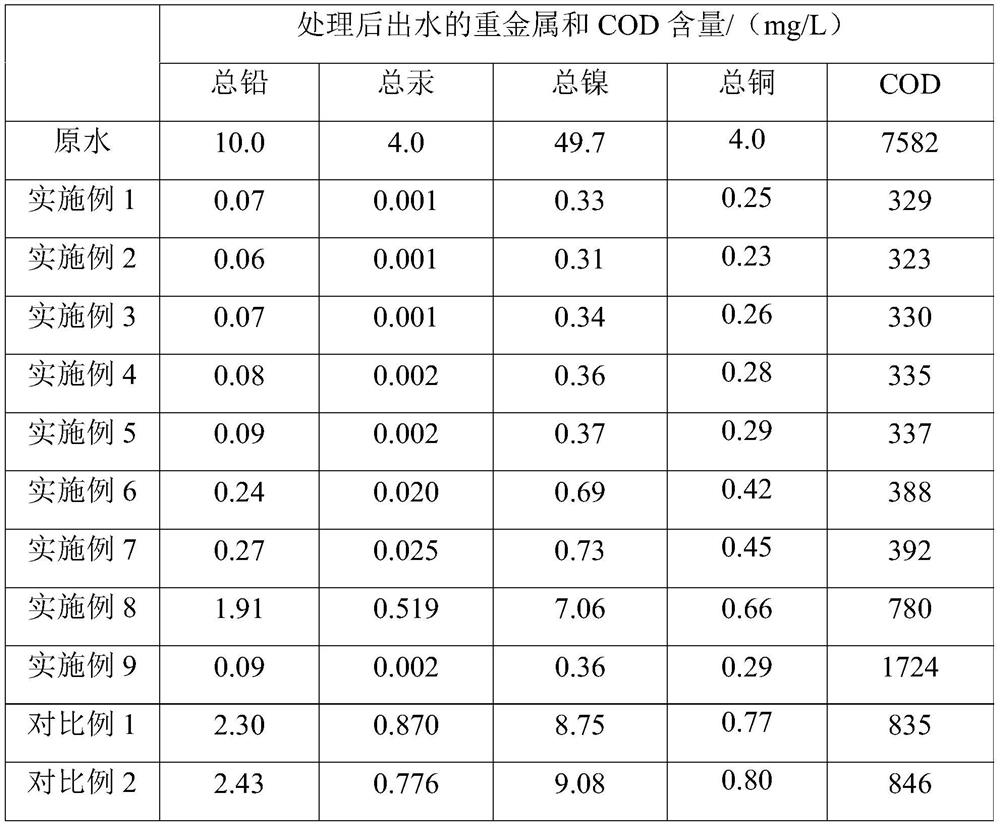Wastewater treatment method for removing heavy metals and reducing COD
A technology for heavy metals and waste water, applied in water/sewage multi-stage treatment, water/sludge/sewage treatment, chemical instruments and methods, etc., can solve the problem of difficulty in removing heavy metal COD well
- Summary
- Abstract
- Description
- Claims
- Application Information
AI Technical Summary
Problems solved by technology
Method used
Image
Examples
Embodiment 1
[0040] (1) discharge the waste water into the regulating tank, and adjust the pH value of the waste water to 8.8;
[0041](2) After the treatment in step (1), the wastewater flows into the reaction pool, and 2000 mg of polysilicate ferric sulfate is added per L of wastewater. After stirring for 12 minutes, 13 mg of cationic polyacrylamide with a cationic degree of 60% is added per L of wastewater. , continue to stir and react for 7min;
[0042] (3) After the step (2) is processed, the mixed solution flows into the sedimentation tank for sedimentation and separation. The residence time is 12min. 60% of the floc precipitation in the lower floor obtained by the sedimentation separation is returned to the reaction tank, and the remaining flocs are concentrated and filtered. Buried, the floc concentrated supernatant and press-filtered water are returned to the reaction tank;
[0043] (4) The effluent of the sedimentation tank (that is, the supernatant liquid separated by sedimenta...
Embodiment 2
[0046] (1) discharge the waste water into the regulating tank, and adjust the pH value of the waste water to 8.6;
[0047] (2) After the treatment in step (1), the waste water flows into the reaction pool. Add polyferric sulfate at 1650 mg per L of waste water. After stirring for 9 minutes, add cationic polyacrylamide with a cationic degree of 50% at 11 mg per L of waste water. Continue Stir the reaction for 6 minutes;
[0048] (3) After the step (2) is processed, the mixed solution flows into the settling tank for sedimentation and separation, the residence time is 10min, and 50% of the floc precipitation of the lower floor obtained by the sedimentation separation is returned to the reaction tank, and the remaining floc precipitation is concentrated and press-filtered, Landfill, concentrated supernatant and press filtered water back to the reaction tank;
[0049] (4) The effluent of the sedimentation tank (that is, the supernatant liquid separated by sedimentation) enters th...
Embodiment 3
[0052] (1) discharge the waste water into the regulating tank, and adjust the pH value of the waste water to 8.3;
[0053] (2) After the step (1) is processed, the waste water flows into the reaction pool, and polyferric chloride is added at 1250 mg per L of waste water, and after stirring for 6 minutes, 9 mg per L of waste water is added with cationic polyacrylamide having a cationic degree of 50%. Continue to stir and react for 5min;
[0054] (3) after the step (2) is processed, the mixed solution flows into the settling tank for sedimentation and separation, the residence time is 8min, and 40% of the floc precipitation of the lower floor obtained by the sedimentation separation is returned to the reaction tank, and the remaining floc precipitation is concentrated and press-filtered, Landfill, concentrated supernatant and press filtered water back to the reaction tank;
[0055] (4) The effluent of the sedimentation tank (that is, the supernatant liquid separated by sediment...
PUM
 Login to View More
Login to View More Abstract
Description
Claims
Application Information
 Login to View More
Login to View More - R&D
- Intellectual Property
- Life Sciences
- Materials
- Tech Scout
- Unparalleled Data Quality
- Higher Quality Content
- 60% Fewer Hallucinations
Browse by: Latest US Patents, China's latest patents, Technical Efficacy Thesaurus, Application Domain, Technology Topic, Popular Technical Reports.
© 2025 PatSnap. All rights reserved.Legal|Privacy policy|Modern Slavery Act Transparency Statement|Sitemap|About US| Contact US: help@patsnap.com


